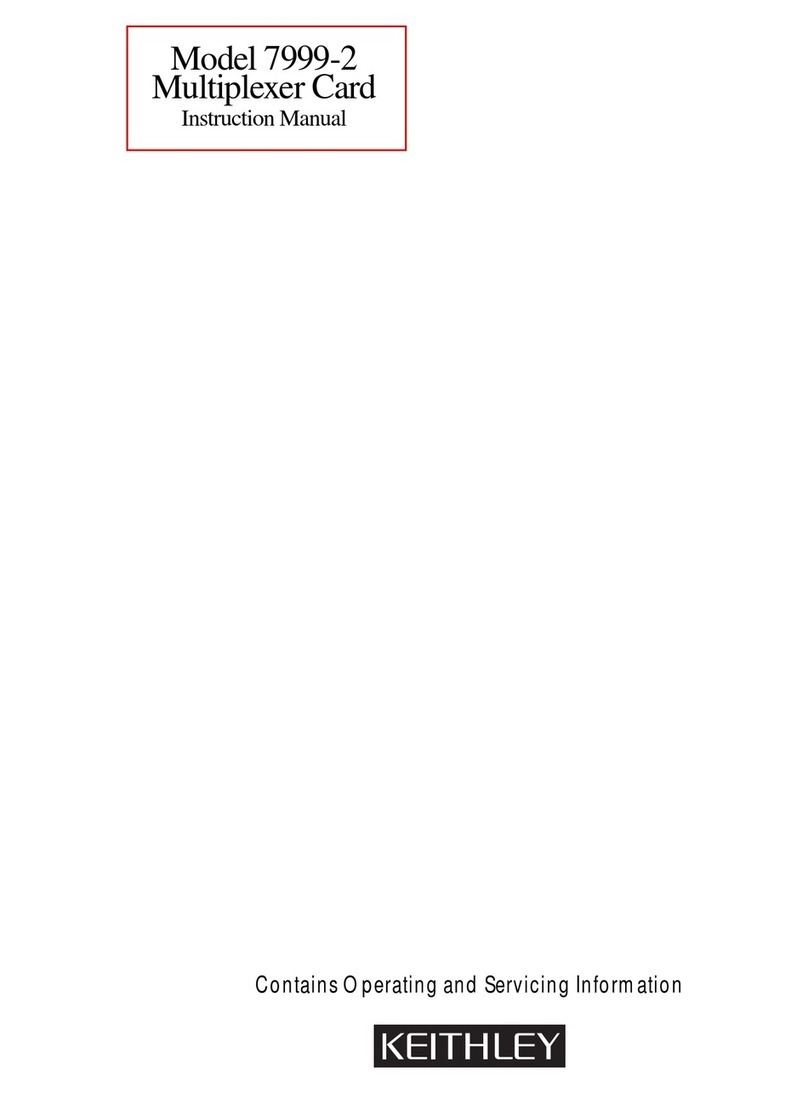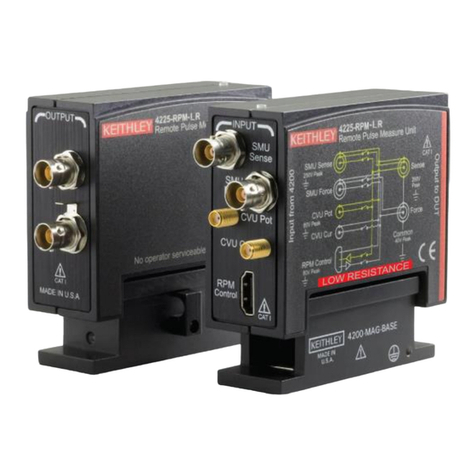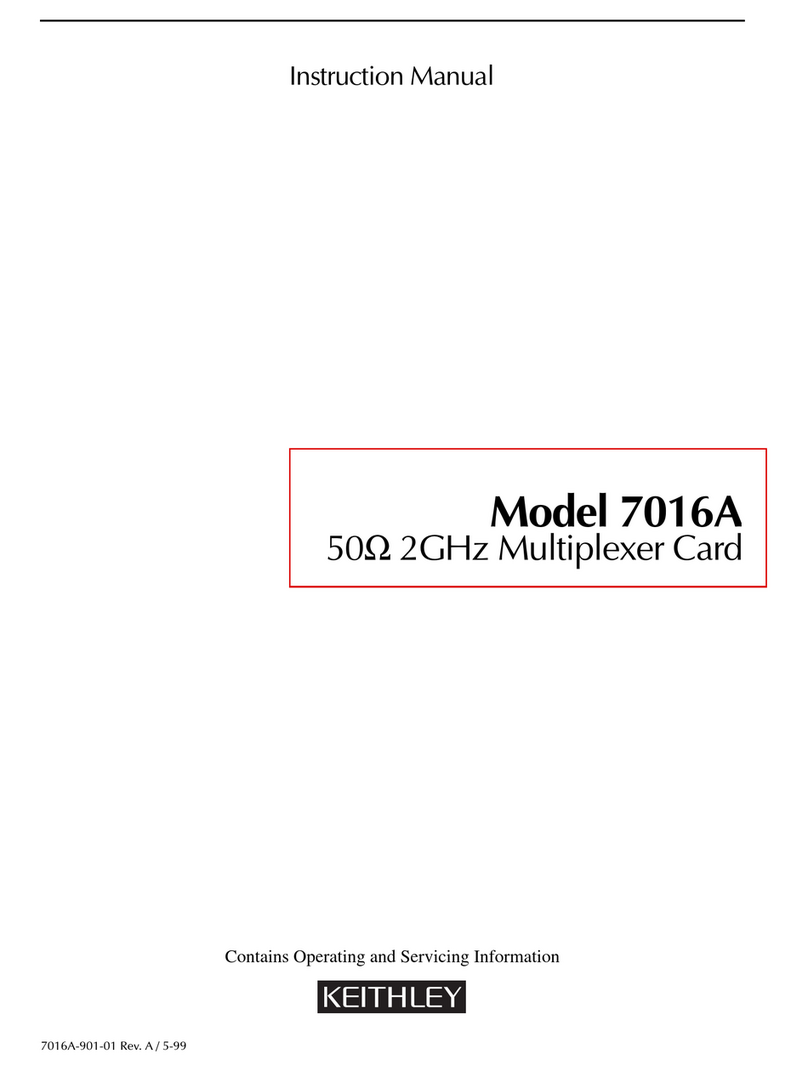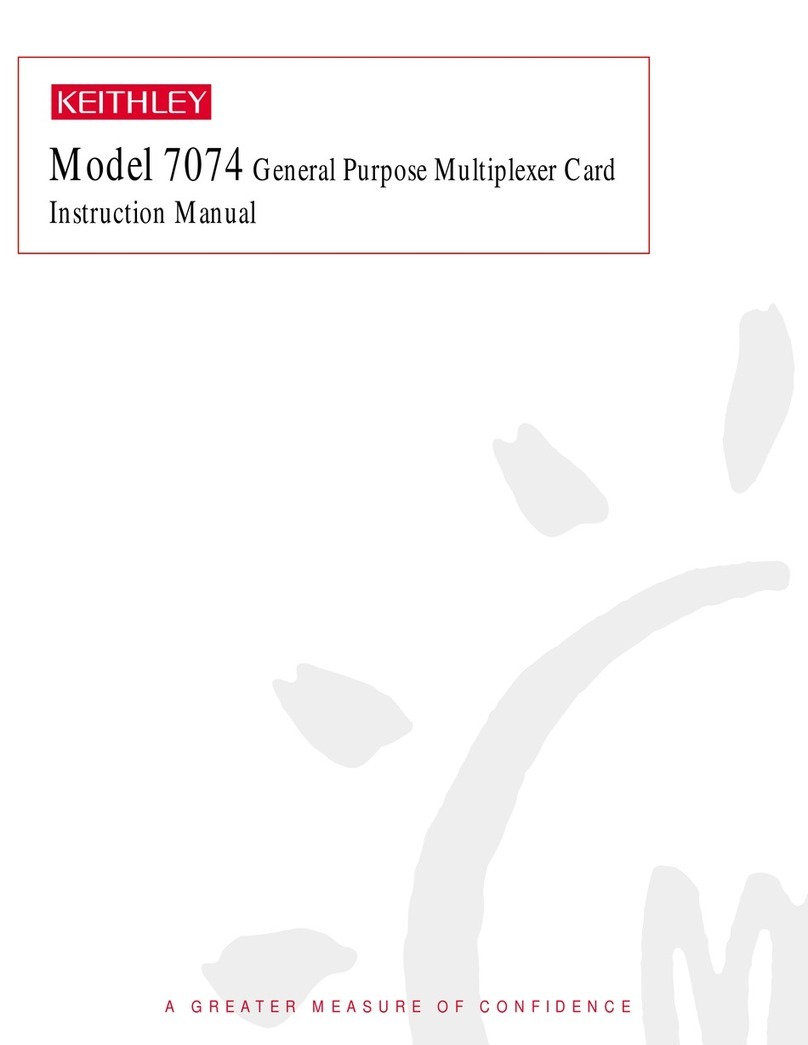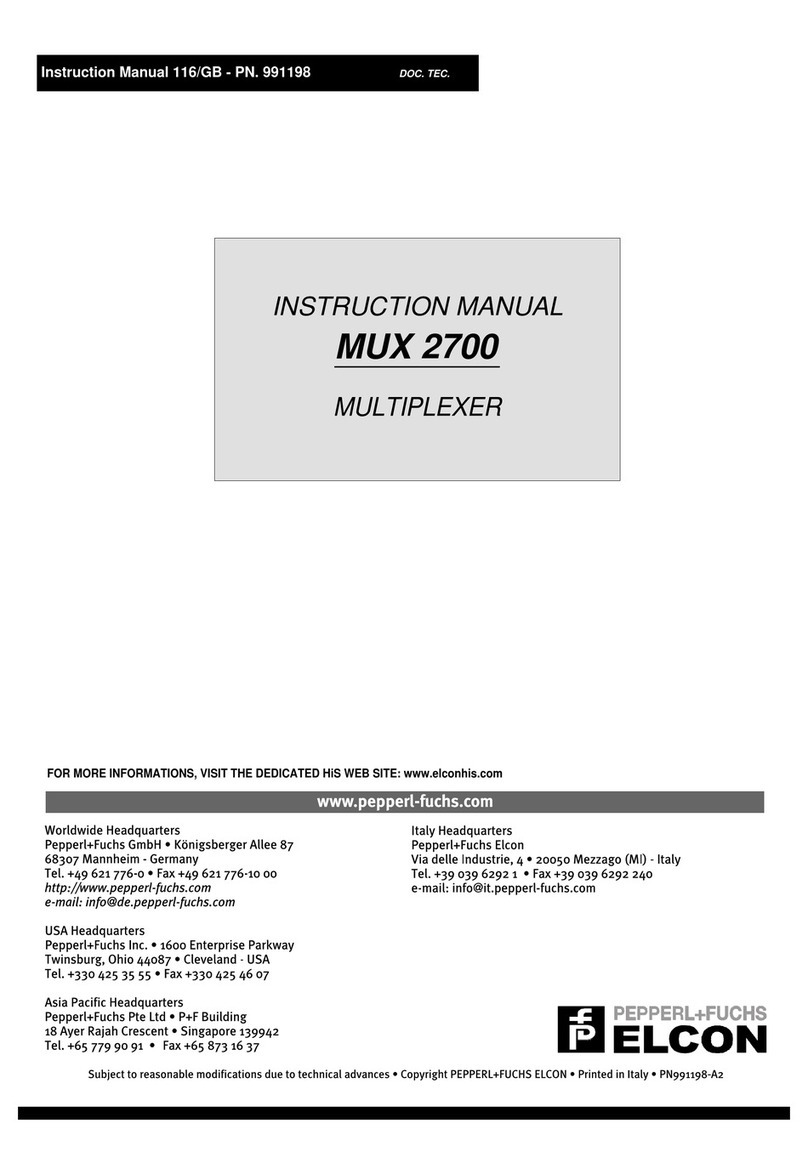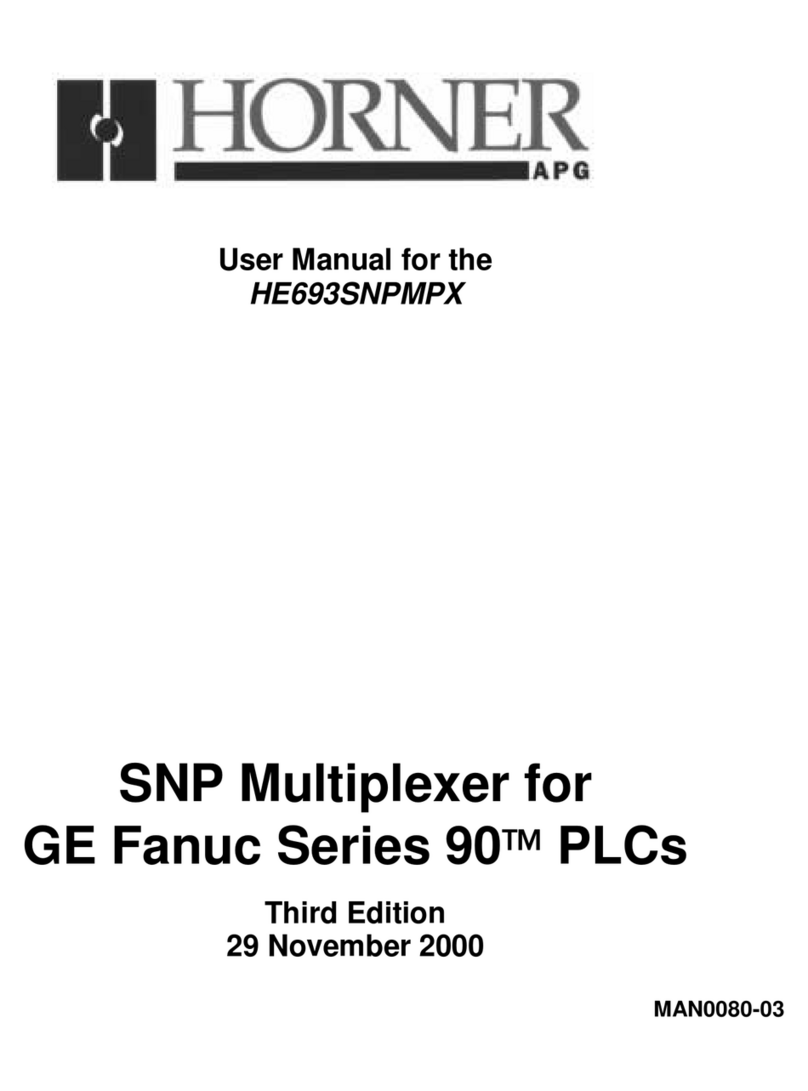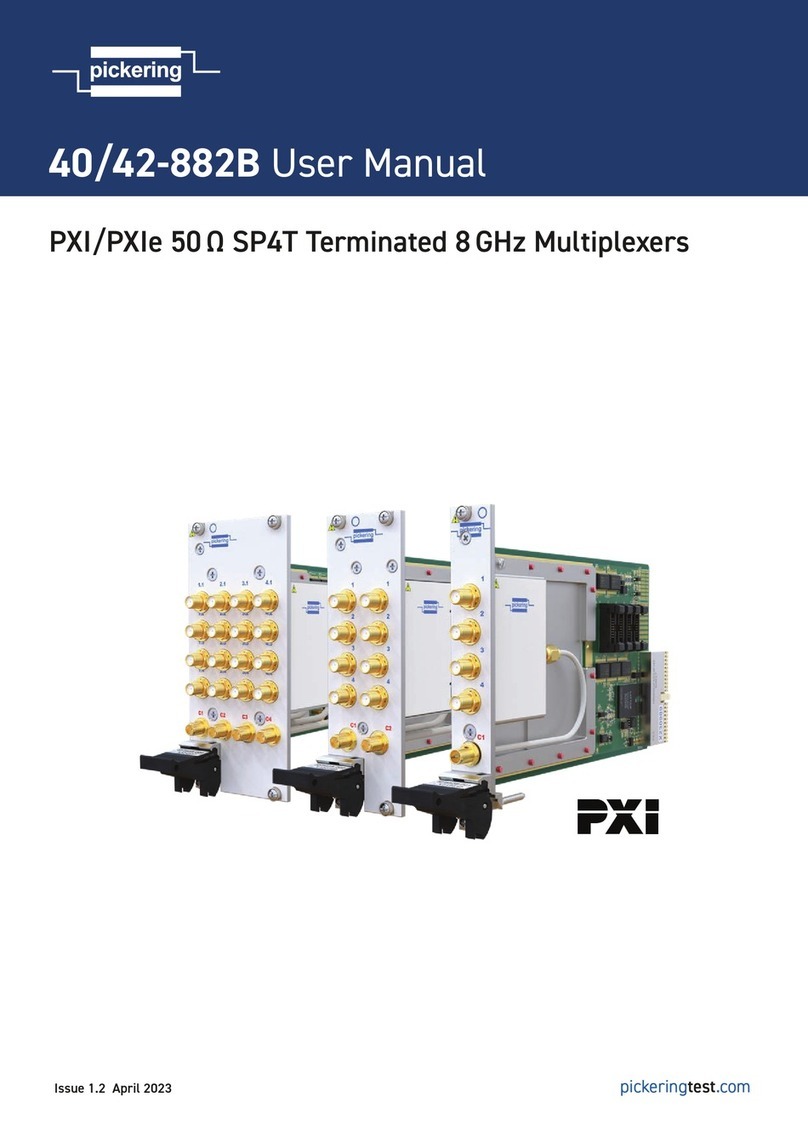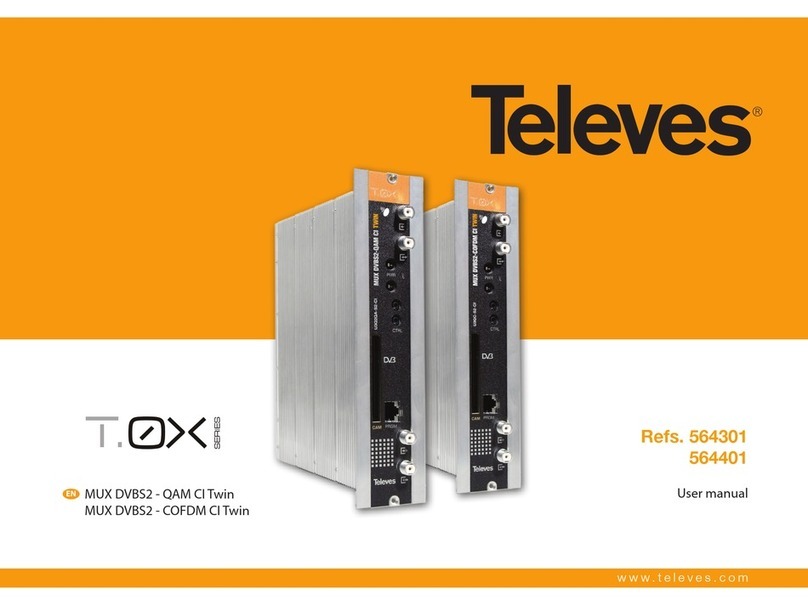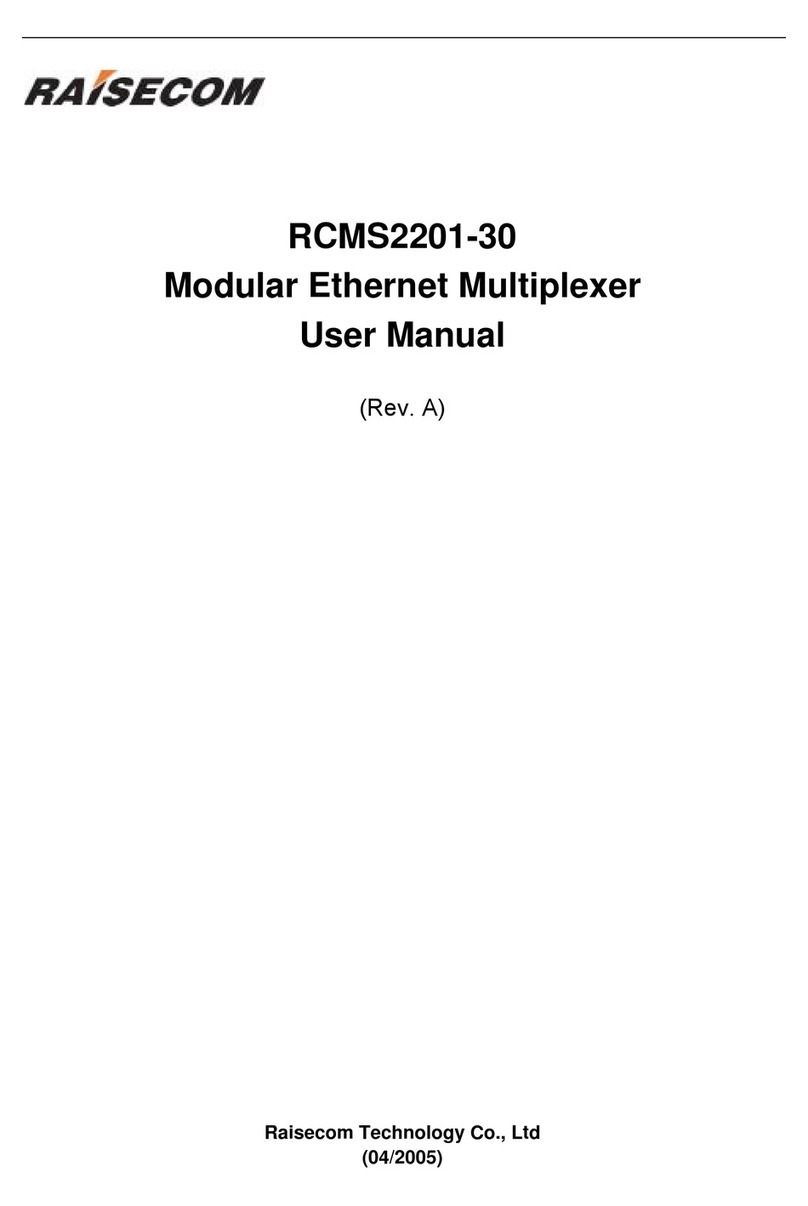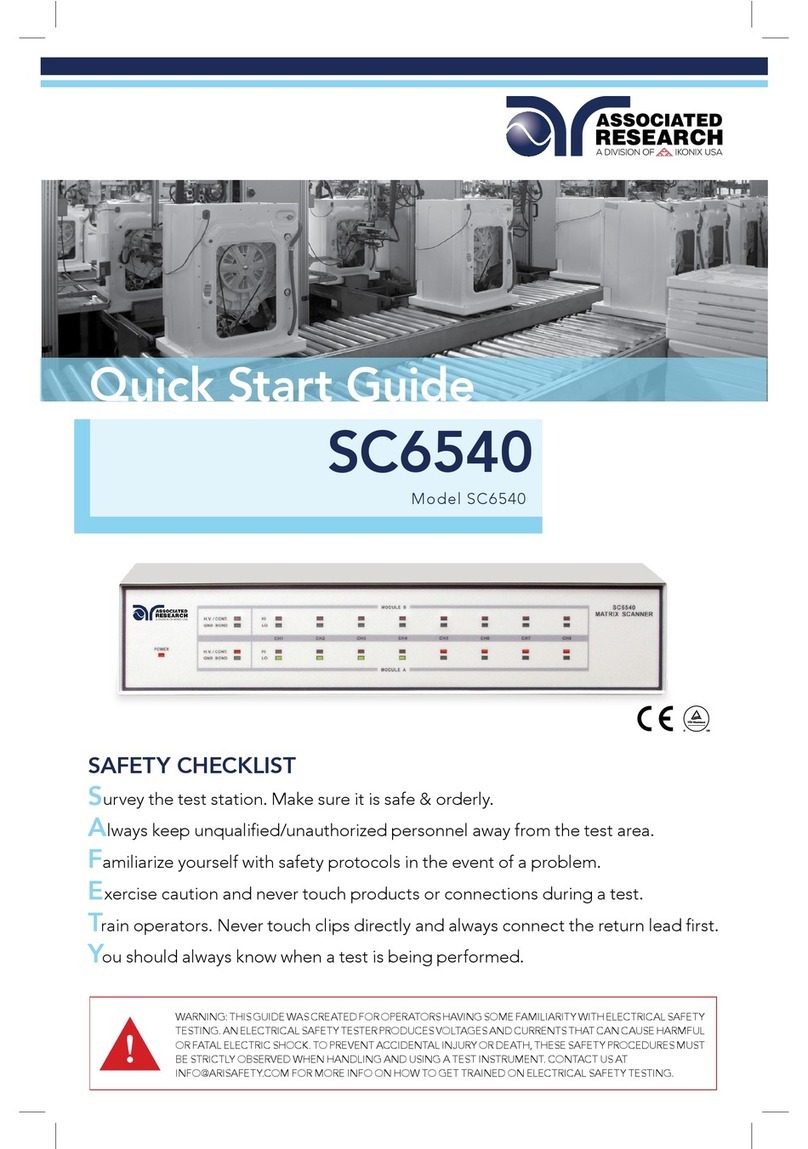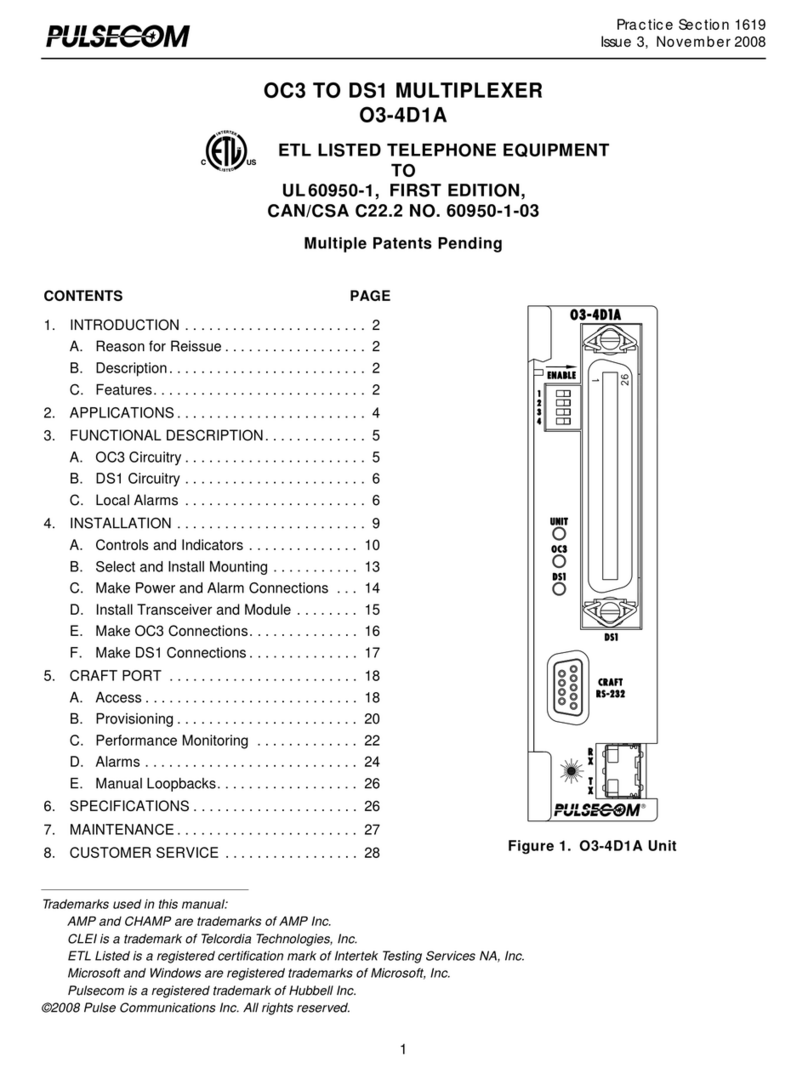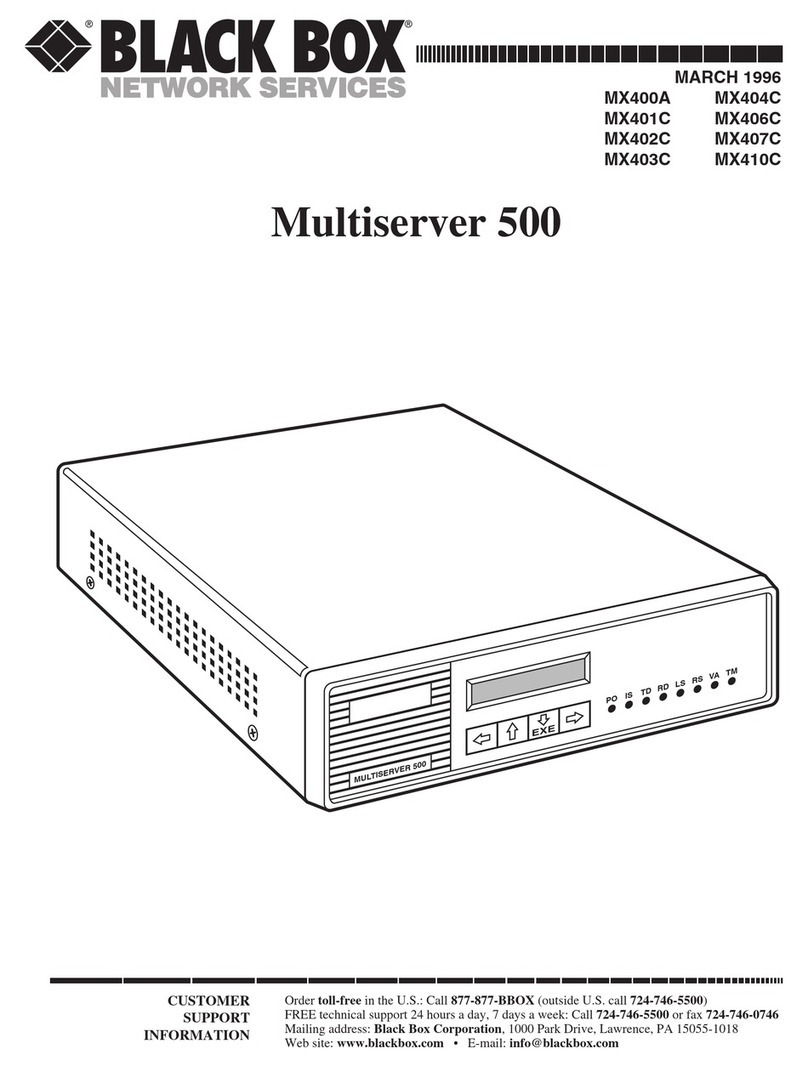Keithley 7014 User manual

The test & measurement
equipment you need at
the price you want.
Alltest carries the world’s largest selection of
used/refurbished benchtop test & measurement
equipment at 50% the price of new.
O
Our equipment is guaranteed working, warrantied, and
available with certified calibration from our in-house staff
of technicians and engineers.
• 10+ full time technicians with over 150 years of
specialization
• 90 day warranty & 5 day right of return on all
equipment
•
• 1-3 year warranties for new and
premium-refurbished equipment
• Every unit tested to OEM specifications
• Satisfaction guaranteed
You have plans, we will help you achieve them.
Any project. Any budget.
Get a quote today!
CCall (732) 919-3339 or email sales@alltest.net.
t
Alltest Instruments, Inc.
500 Central Ave.
Farmingdale, NJ 07727
P: (732) 919-3339
F: (732) 919-3332
alltest.net
s
sales@alltest.net

WARRANTY
Keithley Instruments, Inc. warrants this product to be free from defects in material and workmanship for a period of 1 year
from date of shipment.
Kcithley Instruments, Inc. warrants the following items for 90 days from the date of shipment: probes, cables, rechargeable
batteries, diskettes, and documentation.
During the warranty period, WCwill, at our option, either repair or replace any product that proves to be defect&
To exercise this warranty, write or call your local Keithley representative, or contact Keithley headquarters in Cleveland, Ohio.
You will be given prompt assistance and return instructions. Send the product, transportation prepaid, to the indicated service
facility. Repairs will be made and the product returned, transportation prepaid. Repaired or replaced products are warranted for
the balance of the original warranty period, or at least 90 days.
LIMITATION OF WARRANTY
This warranty does not apply to defects resulting from product modification without Keithley’s express written consent, or
misuse of any product or part, This warranty also does not apply to fuses, software, non-rechargcahle batteries, damage from
battery leakage, or problems arising from normal wear or failure to follow instructions.
THIS WARRANTY IS IN LIEU OF ALL OTHER WARRANTIES, EXPRESSED OR IMPLIED, INCLUDING ANY
IMPLIED WARRANTY OF MERCHANTABILITY OR FITNESS FOR A PARTICULAR USE. THE REMEDIES PRO-
VIDED HEREIN ARE BUYER’S SOLE AND EXCLUSIVE REMEDIES.
NEITHER KEITHLEY INSTRUMENTS, INC. NOR ANY OF ITS EMPLOYEES SHALL BE LIABLE FOR ANY DIRECT,
INDIRECT, SPECIAL, INCIDENTAL OR CONSEQUENTIAL DAMAGES ARISING OUT OF THE USE OF ITS
INSTRUMENTS AND SOFTWARE EVEN IF KFITHLEY INSTRUMENTS, INC., HAS BEEN ADVISED IN ADVANCE
OF THE POSSIBILITY OF SUCH DAMAGES. SUCH EXCLUDED DAMAGES SHALL INCLUDE, BUT ARE NOT LIM-
ITED TO: COSTS OF REMOVAL AND INSTALLATION, LOSSES SUSTAINED AS THE RESULT OF INJURY TO ANY
PERSON, OR DAMAGE TO PROPERTY.

Model 7014 Instruction Manual
01992, Keithley Instruments, Inc.
All Rights Reserved
Cleveland, Ohio, U. S. A.

Manual Print History
The print history shown below lists the printing dates of all Revisions and Addenda created for this manual. The
Revision Level letter increases alphabetically as the manual undergoes subsequent updates. Addenda, which are
released between Revisions, contain important change information that the user should incorporate immediately
into the manual. Addenda are numbered sequentially. When a new Revision is created, all Addenda associated
with tlw previous Revision of the manual are incorporated into the new Revision of the manual. Each new Revi-
sion includes a revised copy of this print history page.
revision A (Document Number 70~901.01) ............................................................................October 1992
Revision B (Document Number 7014.901-01).........................................................................
November 1992

Safety Precautions
The following safety precautions should be observed bcforc using
this product and any associated instrumentation. Although some in-
stmmcnt~ and accessories would nomxally bc used with non-haz-
ardous voltages, there are situations where hazardous conditions
may be presem.
This producl is intended for use by qualified personnel who recog-
nize shock hazards and are familiar with the safely precautions rc-
quired to avoid possible injury. Read the operating information
arcfully before using the product.
The types of product users are:
Responsible body is the individual or group responsible for the USC
and maintenance of cquipmcnt. for ensuring that the equipment is
operated within its spccitications and operating limits, and for en-
suring that operators are adequately trained.
Operators use the product for its intended function. They mull be
trained in electrical safety procedures and proper use of the instru-
ment. They must be protected from electric shock and contact with
hazardous live circuits.
Maintenance personnel pafonn routine procedures on the product
to keep it operating, for example, setting the line voltage or replac-
ing consumable materials. Maintenance procedures are described in
the manual. The procedures explicitly state if the operator may pcr-
form them. Otherwise, they should be performed only by service
pxs0”“e1.
Service personnel are trained to work on live circuits, and perform
safe installations and repairs of pmducts. Only properly trained ser-
vice personnel may perform installation and sen%x procedures.
Exercise extreme caution when a shock hazard is present. Lethal
voltage may be present on cable connector jacks or test fixtures. The
American National Sandards Institute (ANSI) states that B shock
hazard exists when voltage levels greater than 30V RMS, 42.4V
peak, or 60VDC are present. A good safety practice is to expect
that hazardous voltage is present in any unknown circuit before
measuring.
Users of this product must bc protected from electric shock at all
times. The rcsponsiblc body must ensure that users are prevented
accessand/or insulated from every connection point. In some c.xses.
connections must bc exposed to potendal human contact. Product
users in these circumstances must bc trained to protect thcn~scl~es
from the risk of electric shock. If the circuit is capable of operating
at or above 1000 volts, no conductive part of the circuit may be
exposed.
As described in the lntemetional Elcctrmcchnical Commission
(IEC) Standard IEC 664, digital muldmeter measuring circuits
(e.g.. Kcithley Models 175A, 199.2000. 2001. 2002. and 2010) arc
lnstallatiou Category II. All other instruments signal terminals are
Installation Category I and must not bc connected to mains.
Do not connect switching cards directly to unlimited power circuits.
‘hey arc intended to be used with impcdancc limiled sources.
NEVER connect switching cards directly to AC mains. When con-
necting sources to switching cards. install protective devices to iim
it fault current and voltage to the card
Before operating an inwument, make sure the lint cord is connects
ed to Bproperly grounded power receptacle. lnspcct the connecting
cables. test leads, and jumpers for possible wear, cracks. or brwks
before each use.
For maximum safety, do not touch the product. test cables, or .vly
other inatrumcnrs while power is applied to the circuit under test.
ALWAYS remove power from the entire test system and discharge
any capacitors before: connecting or dirconnecdng cables or jumpy
em, instdting Or removing switching cards, or making internal
changes, such as installing or removing jumpers.
Do not touch any object that could provide a current path to the
common side of the circuit under test or power line (earth) ground.
Always make ,,,~a~“rcm~“ts with dry hands while standing on a
dry, insulaled surface capable of withstanding the voltage being
measured.

The instrument and accessories must be used in accordance with its
specifications and operating instructions or the safety of the cquip-
ment may be impaired.
Do not exceed the maximum signal levels of the instruments and ac-
cessories, as defined in the specifications and operating informa-
tion, and as shown on the instrument or test fixture panels, or
switching card.
When fuses are used in aproduct, replace with fame type and rating
for continued protection against fire hazard.
Chassis connections must only be used as shield connections for
measuring circuits, NOT as safety earth ground connections.
If you are using a test fixture, keep the lid closed while power is ap-
plied to the device under test. Safe operation requires the use of a
lid interlock.
Ifa@ screw is present, connect it to safety earth ground using the
wire recommended in the user documentation.
Then. symbol on an instrument indicates that the user should re-
ker to the operating instructions located in tbc manual.
men symbol on an instrument shows that it am source ormea-
sure 1000 volts or more, including tbc combined effect of normal
and common mode voltages. Use standard safety precautions to
avoid personal contact with thcsc voltages.
The WARNING heading in a manual explains dangers that might
result in personal injury or death. Always read the associated infor-
mation very canfully before performing the indicated procedure.
The CAUTION heading in a manual explains hazards that could
damage the instrument. Such damage may invalidate the warranty.
Instrumentation and accessarics shall not be connected to humans.
Before performing any maintenance, disconnect the line cord and
all test cables.
To maintain protection from electric shock and tire, replacement
components in mains circuits, including the power transformer, test
leads, and input jacks, must be purchased from Keirhley hutn-
menrs. Standard fuses, with applicable national safety approvals,
may be used if the rating and type are the same. Other components
that are not safety related may be purchased from other suppliers as
long asthey arc equivalent to the original component. (Note that se-
lected parts should be purchased only through Keithley lnstmments
to maintain accuracy and functionality of the product.) If you are
unsure about the applicability of a replacement component, call a
Keithley Instruments office for information.
To clean an instrument, USCa damp cloth or mild, water based
cleaner. Clean the exterior of the instrument only. Do not apply
cleaner directly to the instmmcnt or allow liquids to enter or spill
on the instrument. Products that consist of a circuit board with no
case or chassis (c.g., data acquisition board for installation into a
computer) should never require cleaning if handled according to in-
structions. If the board becomes contaminated and opertiion is af-
fected, the board should bc returned to the factory for proper
clcaning/scrvicing.
Rev. IO/99

Model 7014
39 Channel Thermocouple/General Purpose Multiplexer
10.7’C ((PCto 18°C and 2FC to M”C).
REFERENCE o-: +*wu”Pc ,+SP.mn” at 0°C).
+
Bankss-‘

Table of Contents
1 General Information
1.1
1.2
1.3
1.4
1.5
1.6
1.7
1.7.1
1.72
1.7.3
1.7.4
1.8
2.1
2.2
2.2.1
2.2.2
2.2.3
2.2.4
2.3
2.3.1
2.3.2
2.4
2.4.1
2.4.2
2.4.3
2.4.4
2.4.5
2.5
2.5.1
2.5.2
Introduction ...................................................................................................................................................... 1-l
Features.. ............................................................................................................................................................ 1-l
Warranty information.. .................................................................................................................................... 1-2
Manual addenda .............................................................................................................................................. 1-2
Safety symbols and terms ............................................................................................................................... 1-2
Specifications .................................................................................................................................................... 1-2
Unpacking and inspection.. ............................................................................................................................ t-2
Inspection for damage.. ........................................................................................................................... 1-2
Shipping contents.. ................................................................................................................................... 1-2
Instruction manual.. ................................................................................................................................. l-3
Repacking for shipment.. ........................................................................................................................ l-3
Optional accessories ......................................................................................................................................... l-3
Multiplexing Basics
Introduction ...................................................................................................................................................... 2-l
Thermocouple measurements ........................................................................................................................ .2-l
Definitions .................................................................................................................................................. 2-l
Theory ......................................................................................................................................................... 2-l
Measurement procedure .......................................................................................................................... 2-2
Measuring example.. ................................................................................................................................. 2-2
Basic multiplexer configurations ................................................................................................................... 2-3
Multiplexer bank-to-bank jumpers ........................................................................................................ 2-4
Backplane jumpers ................................................................................................................................... 2-6
Typical multiplexer switching schemes.. ...................................................................................................... 2-7
Thermocouple switching.. ........................................................................................................................ 2-7
Single-ended switching ........................................................................................................................... 2-8
Differential switching .............................................................................................................................. 2-8
Sensing ....................................................................................................................................................... 2-9
SMU connections ...................................................................................................................................... 2-9
Multiplexer expansion ................................................................................................................................... Z-10
Two-card switching systems ................................................................................................................ Z-10
Mainframe multiplexer expansion ...................................................................................................... 2-l 1

3 Card Connections & Installation
3.1
3.2
3.3
3.3.1
3.3.2
3.3.3
3.4
3.4.1
3.4.2
3.4.3
3.5
Introduction.. ..................................................................................................................................................... 3-1
Handling precautions ...................................................................................................................................... 3-l
Connections ....................................................................................................................................................... 3-l
Bank-to-bank jumpers.. ............................................................................................................................ 3-2
Backplane jumpers ................................................................................................................................... 3-4
Screw terminal connector card ............................................................................................................... 3-4
Typical connection schemes.. .......................................................................................................................... 3-6
Single card system.. .................................................................................................................................. 3-6
Two-card system.. ..................................................................................................................................... 3-9
Two-mainframe system.. ......................................................................................................................... 3-9
Model 7014 installation and removal .......................................................................................................... 3-12
4
4.1
4.2
4.3
4.3.1
4.3.2
4.3.3
4.4
4.4.1
4.4.2
4.4.3
4.4.4
4.5
4.5.1
4.5.2
4.5.3
4.5.4
4.5.5
4.5.6
4.5.7
Operation
Introduction.. ..................................................................................................................................................... 4-l
Power limits.. ..................................................................................................................................................... 4-1
Mainframe control of multiplexer card.. ....................................................................................................... 4-l
Channel assignments ............................................................................................................................... 4-l
Front panel control ................................................................................................................................... 4-3
IEEE-488 bus operation.. .......................................................................................................................... 4-4
Multiplexer switching examples .................................................................................................................... 4-5
Thermocouple scanning .......................................................................................................................... 4-5
Resistor testing.. ........................................................................................................................................ 4-5
Transistor testing .................................................................................................................................... 4.10
Resistor temperature coefficient testing.. ............................................................................................. 4.10
Measurement considerations ........................................................................................................................ 4.13
Thermocouple measurement error sources ........................................................................................ 4-13
Path isolation.. ......................................................................................................................................... 4-14
Magnetic fields.. ...................................................................................................................................... 4-15
Radio frequency interference.. .............................................................................................................. 4-15
Ground loops .......................................................................................................................................... 4-15
Keeping connectors clean.. .................................................................................................................... 4-16
AC frequency response.. ........................................................................................................................ 4-16
5 Service Information
5.1
5.2
5.3
5.3.1
5.3.2
5.3.3
5.3.4
5.3.5
5.3.6
5.3.7
5.3.8
5.4
Introduction.. ..................................................................................................................................................... 5-l
Handling and cleaning precautions.. ............................................................................................................. 5-l
Performance verification................................................................................................................................... 5-2
Environmental conditions ....................................................................................................................... 5-2
Recommended equipment ...................................................................................................................... 5-2
Reference junction test .............................................................................................................................. 5-3
Channel resistance tests.. ......................................................................................................................... 5-5
Offset current tests.. .................................................................................................................................. 5-6
contact potential tests.. ............................................................................................................................ 5-E
Bank and channel-to-channel isolation tests ........................................................................................ 5.9
Differential and common-mode isolation tests .................................................................................. 5.13
Calibration.. ...................................................................................................................................................... 5.15
ii

5.4.1
5.4.2
5.5
5.6
5.6.1
5.6.2
5.6.3
5.6.4
5.6.5
5.7
5.7.1
5.7.2
5.7.3
Calibration with thermistor probe.. ..................................................................................................... .5-15
Calibration with thermocouple wire.. .................................................................................................. 5-17
Special handling of static-sensitive devices ................................................................................................ 5-19
..
Prlnc1ples of operation ................................................................................................................................... 5-19
Block diagram ........................................................................................................................................ 5-19
ID data cncults......................................................................................................................................... 5-20
Relay control .......................................................................................................................................... 5-21
Reference junction ................................................................................................................................. 5-21
Power-on safeguard .............................................................................................................................. 5-21
Troubleshooting ............................................................................................................................................ 5-21
Troubleshooting equipment ................................................................................................................ 5-21
Troubleshooting access......................................................................................................................... 5-21
Troubleshooting procedure ................................................................................................................. 5-22
6 Replaceable Parts
6.1 Introduction ..................................................................................................................................................... 6-l
6.2 Parts lists.. ......................................................................................................................................................... 6-1
6.3 Ordering information ..................................................................................................................................... 6-l
6.4 Factory service ................................................................................................................................................. 6-l
6.5 Component layouts and schematic diagrams. ............................................................................................ 6-l
iii/iv

List of IIlustrations
2
Figure 2-1
Figure 2-2
Figure 2-3
Figure 2-4
Figure 2-5
Figure 2-6
Figure 2-7
Figure 2-8
Figure 2-9
Figure Z-10
Figure 2-11
Figure 2-12
Figure 2-13
Figure 2-14
Figure 2-15
3 Card Connections & Installation
Figure 3-l Bank-to-bank jumper locations .............................................................................................................. 3-2
Figure 3-2 Bank-to-bank jumper termmal ldenhficahon
.......................................................................................... 3-3
Figure 3-3 Connector card mounting screw.. ........................................................................................................... 3-3
Figure 3-4 Bank-to-bank jumper installation .......................................................................................................... 3-4
Figure 3-5 Backplane jumpers ................................................................................................................................... 3-4
Figure 3-6 Model 7014 screw terminal connector card .......................................................................................... 3-5
Figure 3-7 Typical screw terminal connections ...................................................................................................... 3-6
Figure 3-8 Cable clamp for screw terminal connector card .................................................................................. 3-6
Figure 3-9 Single card (1 x 39) system example.. ..................................................................................................... 3-7
Figure 3-10 Single card (1 x 19 and 1 x 20) system example.. .................................................................................. 3-8
Figure 3-11 Two-card system example .................................................................................................................... 3-10
Figure 3-12 Two-mainframe system example.. ....................................................................................................... 3-11
Figure 3-13 Model 7014 card installation in Model 7001....................................................................................... 3-13
Multiplexing Basics
Thermocouple measurement ................................................................................................................... 2-2
Model 7014 simplified schematic ........................................................................................................... 2-3
Four 1 x 10 multiplexer configuration (jumpers not installed) ......................................................... 2-4
Two 1 x 20 multiplexer configuration (jumpers installed). ................................................................ 2-5
One 1 x 40 multiplexer configuration (jumpers installed) ................................................................. 2-5
Model 7001 analog backplane.. .............................................................................................................. 2-6
Bank connections to backplane .............................................................................................................. 2-7
Thermocouple switching example.. ....................................................................................................... .2-7
Single-ended switching example ........................................................................................................... .2-8
Differential switching example .............................................................................................................. 2-8
Sensing example ....................................................................................................................................... 2-Y
SMU connections.. .................................................................................................................................. Z-10
Two separate multiplexer systems ...................................................................................................... 2-l 1
Multiplexer input expansion example ................................................................................................ Z-12
Mixed card type example ...................................................................................................................... 2-12
4 Operation
Figure 4-l Channel status display ,,,,,,,....,.,,,,..,,,,,,,.,,.,,,,,,....,,.,,...,...,,,,,,,,,,.,....,,......,.......................,,,..................... 4-2
Figure 4-2 Display organization for multiplexer channels . . . . . . 4-2
”

Figure 4-3 Model 7014 programming channel assignments ................................................................................. 4-3
Figure 4-4 Thermocouple scanning ........................................................................................................................... 4-6
Figure 4-5 Z-wire resistance testing .......................................................................................................................... 47
Figure 4-6 4.wire resistance testing .......................................................................................................................... 4-7
Figure 4-7 Low resistance testing.. ............................................................................................................................ 4-9
Figure 4-8 Configuration for current gain and common-emitter test ................................................................ 4-11
Figure 4-9 Resistor temperature coefficient testing.. ............................................................................................. 4-12
Figure 4-10 Typical common-emitter characteristics ............................................................................................. 4-13
Figure 4-11 ..
Path lsolatlon resistance.......................................................................................................................... 4-14
Figure 4-12 Voltage attenuation by path isolation resistance ............................................................................... 4-15
Figure 4-13 Power lie ground loops ....................................................................................................................... 4-16
Figure 4-14 Eliminating ground loops ..................................................................................................................... 4-16
5
Service Information
Figure 5-l
Figure 5-2
Figure 5-3
Figure 5-4
Figure 5-5
Figure 5-6
Figure 5-7
Figure 5-8
Figure 5-9
Figure S-10
Figure 5-11
Figure 5-12
Figure S-13
Reference junction test .............................................................................................................................. 5-4
Path resistance test connections ............................................................................................................. 5-5
Differential offset current test connections.. ......................................................................................... 5-7
contact potential test connections ......................................................................................................... 5-8
..
Bank lsolahon test connections ............................................................................................................... 5-9
Channel-to-channel isolation test connections.. ......
........................................................................... 5-11
Differential isolation test connections ................................................................................................. S-13
Common-mode isolation test connections.. ........................................................................................ S-15
Calibration with thermistor probe ........................................................................................................ 5-16
Calibration with thermocouple wire .................................................................................................... 5-18
Model 7014 block diagram .................................................................................................................... S-19
Start and stop sequences ........................................................................................................................ S-20
Transmit and acknowledge sequence ‘................................................................................................. 5-20
vi

List of Tables
3
Table 3-l
Card Connections & installation
Bank-to-bank jumpers (refer to Figure 3-2) ,,,......,.,.,,,,,,,,,,,,,,,,..........,............ ,,,,,,,,,........................ 3-3
4
Table 4-1
Operation
Paired Channels in 4-p& Operation ....___....,,...............................................~. ,......,.,,,,....,.....,.,....... 4-8
5 Service Information
Table 5-1 Verification and calibration equipment .......................................................... ................................. 5-3
Table 5-2 Bank isolation test summary ............................................................................ ............................... 5-10
Table 5-3 Channel-to-channel isolation test summary .................................................. ............................... 5-12
Table 5-4 Differential and common-mode isolation testing.. ........................................ ............................... 5-14
Table 5-5 Recommended troubleshooting equipment ................................................... ............................... 5-21
Table 5-6 Troubleshooting procedure .................................................................................. ............................... 5-23
vii/viii

General Information
1.1 Introduction
This section contains general information about the
Model 7014 3PChannel Thermocouple/General Pur-
pose Multiplexer Card.
The Model 7014 card is field-installable in the Model
7001 Switch System. Since it combines the functions of
thermocouple switching and a uniform temperature
reference, it is especially useful for scanning thermo-
couples.
The input terminals are covered by an aluminum cover
that acts as an isothermal block to minimize tempera-
ture differences. An
integrated
circuit temperature
transducer under the aluminum cover senses the refer-
ence (cold) junction temperature and converts it to a
proportional voltage. The cold junction temperature is
used to calculate the corrected thermocouple output.
The output voltages of each thermocouple must be
converted to temperature (“C, “F, or K) using appropri-
ate thermocouple tables, polynomial equations, or a
multimeter capable of temperature measurements,
such as the Model 2001.
In addition, any channel can be used for monitoring
low-level signals. The Model 7014 uses 2-p& Form A
contacts for switching of DC signals up to llOV, lA,
30VA (resistive load), and AC signals up to 125V RMS
or 175V peak, lA, 60VA (resistive load).
The rest of Section 1 is arranged in the following man-
*fZr:
1.2
1.3
1.4
1.5
1.6
1.7
1.8
1.9
Features
Warranty information
Manual addenda
Safety symbols and terms
Specifications
Unpacking and inspection
Repacking for shipment
Optional accessories
1.2 Features
The Model 7014 is a low voltage, two-pole, quad, 1x 10
multiplexer card. Some of the key features include:
l Low contact potential and offset current for mini-
mal effects on low-level signals.
l The connector board detaches from the relay
board
allowing easy access to the screw terminals and
jumpers.
l Easy jumper configuration of one, two,
three or
four multiplexer banks.
l-l

l Backplane jumpers. Cutting jumpers disconnects
multiplexer bank outputs from the Model 7001 an-
alog backplane.
The CAUTION heading used in this manual explains
hazards that could damage the multiplexer card. Such
damage may invalidate the warranty.
1.3 Warranty information 1.6 Specifications
Warranty information is located on the inside front
cover of this instruction manual. Should your Model
7014 require warranty service, contact the Keithley rep-
resentative or authorized repair facility in your area for
further information. When returning the multiplexer
card for repair, be sure to fill out and include the service
form at the back of this manual in order to provide the
repair facility with the necessary information.
1.4 Manual addenda
Model 7014 specifications are found at the front of this
manual. These specifications are exclusive of the mul-
tiplexer mainframe specifications.
1.7 Unpacking and inspection
1.7.1 Inspection for damage
The Model 7014 is packaged in a re-sealable, anti-static
bag to protect it from damage due to static discharge
and from contamination that could degrade its uerfor-
Any improvements or changes concerning the multi-
plexer
card or manual will be exulained in an adden-
hum included with the card. Addenda are provided in
apage replacement format. Simply replace the obsolete
pages with the new pages.
1.5 Safety symbols and terms
The following symbols and terms may be found on an
instrument or used in this manual.
mance. Before removing the card from the bag, observe
the following precautions on handling.
Handling Precautions:
1. Always grasp the card by the side edges and shields.
Do not touch the board surfaces or components.
2. When not installed in a Model 7001 mainframe,
keep the card in the anti-static bag and store it in the
original packing carton.
The A symbol on an instrument indicates that the
user should refer to the operating instructions located
in the instruction manual.
After removing the card from its anti-static bag, inspect
it for any obvious signs of physical damage. Report
any such damage to the shipping agent immediately.
The
symbol on an instrument shows that high
voltage may be present on the terminal(s). Use stan-
dard safety precautions to avoid personal contact with
these voltages.
1.7.2 Shipping contents
The following items are included with every Model
7014
order:
l Model 7014 39.Channel Thermocouple/General
The WARNING heading used in this manual exulains
dangers that might res& in personal injury or heath.
Always read the associated information very carefully
before performing the indicated procedure.
Purpose Multiplexer Card
l Model 7014 Instruction Manual
l Additional accessories as ordered,
1-2

1.7.3 Instruction manual
The Model 7014 Instruction Manual is three-hole
drilled so that it can be added to the three-ring binder
of the Model 7001 Instruction Manual. After removing
the plastic wrapping, place the manual in the binder
following the mainframe instruction manual. Note that
a manual identification tab is included and should pre-
cede the multiplexer card instruction manual.
If an additional instruction manual is required, order
the manual package, Keithley part number 7014-901-
00. The manual package includes an instruction manu-
al and any pertinent addenda.
1.7.4 Repacking for shipment
Should it become necessary to return the Model 7014
for repair, carefully pack the unit in its original packing
carton or the equivalent, and include the following in-
formation:
Advise as to the warranty status of the thermocou-
ple card.
Write AlTENTION REPAIR DEPARTMENT on the
shipping label.
Fill out and include the service form located at the
back of this manual.
1.8 Optional accessories
The following accessories are available for use with the
Model 7014:
Model 7014-ST-This isothermal screw terminal con-
nector card is identical to the one provided with the
Model 7014 assembly. An extra connector card allows
you to wire a second test system.
Model 7401 - This thermocouple wire kit includes
30.5m (100 ft.) of type K (chromcl-alumcl) thcrmocou-
ple wire.
l-3

1-4

2
Multiplexing Basics
2.1
Introduction
This section covers the basics for multiplex switching
and is arranged as follows:
2.2
2.3
2.4
2.5
2.2
Thermocouple measurement basics: Describes
the theory of thermocouple measurements and a
measurement procedure.
Basic multiplexer configurations: Covers the ba-
sic multiplex configurations; quad 1 x 10 config-
uration, dual 1 x 20 configuration and single 1 x
40 configuration. The significance of the back-
plane jumpers is also covered here.
Typical multiplexer switching schemes: Ex-
plains some of the basic ways a multiplexer can
be used to source or measure. Covers single-end-
ed switching, differential (floating) switching
and sensing.
Multiplexer expansion: Discusses the various
configurations that are possible by using multi-
ple cards.
Thermocouple measurements
2.2.1 Definitions
The following terms are defined as they relate to ther-
mocouple circuits and thermocouple switching cards:
Cold junction-The junction that is held at n stable
known temperature. Also known as the reference junc-
tion.
Hot junction -The junction of two dissimilar metals
that is used to measure an unknown temperature. Also
known as the measurement junction.
Isothermal block or cover- The metal block or cover
that equalizes the temperature of thermocouple con-
nections on a switching card.
Reference accuracy
- The maximum error between
sensor and channel inside the isothermal environment.
Also known as temperature offset.
Reference channel - The channel that measures the
temperature of the isothermal environment.
Reference output -The output signal that represents
the temperature of the reference channel. Commonly
specified by a temperature coefficient of wV/“C and an
offset voltage in millivolts at 0°C.
2.2.2
Theory
A thermocouple is a junction formed between two dis-
similar metals. If the temperature of the thermocouple
junction connected to the Model 7014 is T, a voltage E
is developed between leads A and B as shown in Figure
2-1. When connected to a voltmeter, two more junc-
tions (C and D) are formed with the meter terminals,

which are usually copper. The measured voltage is pro-
portional to the difference between temperatures Tand
T7.
Fi@~re 2- 1
Thermocouple measurement
To determine the difference, the thermoelectric proper-
ties of the thermocouple are needed. Data is available
to determine the voltage Y~~-SLIStemperature relation-
ship based on a reference temperature (T1) of 0°C.
Thus, if the thermocouple-to-copper junctions were
maintained at O”C, it would be possible to determine T
by referring to the Thermocouple Reference Tables.
(SeeNIST Monograph 125). The tables list temperature
as a function of the meter reading E,. Since these junc-
tions are not OT, a voltage E, is inhoduced, where:
E, = E - E,
2.2.3 Measurement procedure
The temperature of a thermocouple junction is deter-
mined by the following summarized procedure:
l Measure the reference voltage (E,).
. Calculate the reference temperature (TI).
. Determine the reference correction voltage (E,).
l Measure the thermocouple voltage (E,).
l Calculate the thermocouple correction voltage (E).
l Determine the thermocouple temperature (T).
The complete step-by-step procedure follows:
1. Read the voltage (E,) developed by the Model 7014
reference junction. Assuming a temperature coeffi-
cient of +2OOpV/“C, and an offset voltage of
2.
3.
4.
5.
+54.63mV at O”C, convert the voltage reading to
temperature (TI) with the formula:
T, = (El - 54.63mV) / 0.2mV per “C
T, represents the temperature of the Model 7014
isothermal connections.
Using the thermocouple look-up tables or the fol-
lowing formula, convert the temperature (T,) from
step 1 to a voltage. Use tables matching the type of
thermocouple connected to the Model 7014. E, COT-
responds to the reference voltage that would result
if an actual thermocouple were used as a reference
junction.
E, = a0+ a,T + a,F + a,T3 + a,T4
Make a measurement of the voltage (E,) developed
by the thermocouple connected to the Model 7014.
Add the reference voltage derived in step 2 to the
thermocouple voltage measured in step 3.
E = E, + E,
Convert the voltage sum (E) from step 4 to a tem-
perature (T) using either thermocouple look-up ta-
bles or the formula:
T = a, + a,E + a,E2 + a,E” + a4E4
The values for a, through a4for the supported thermo-
couples are listed in tables located in Appendix A.
2.2.4 Measuring example
A measurement setup uses a Type Jthermocouple. The
voltage developed by the reference junction (channel 1)
is 61.83mV. The voltage read from the thermocouple is
14476pV.
1. Find the temperature of the isothermal connec-
tions. The voltage from the reference sensor is
61.83mV
(61.83mV - 54.63mV) / 0.2mV per “C = 36°C
Using the appropriate formula or thermocouple
look-up tables (see Table 6.32 of NIST Monograph
125), find the equivalent voltage developed by a
Type Jthermocouple at 36°C. This voltage is found
to be 1849.11iv. The formula shown in Step 2 above
would yield 1849.085cLv.
2-2
Table of contents
Other Keithley Multiplexer manuals
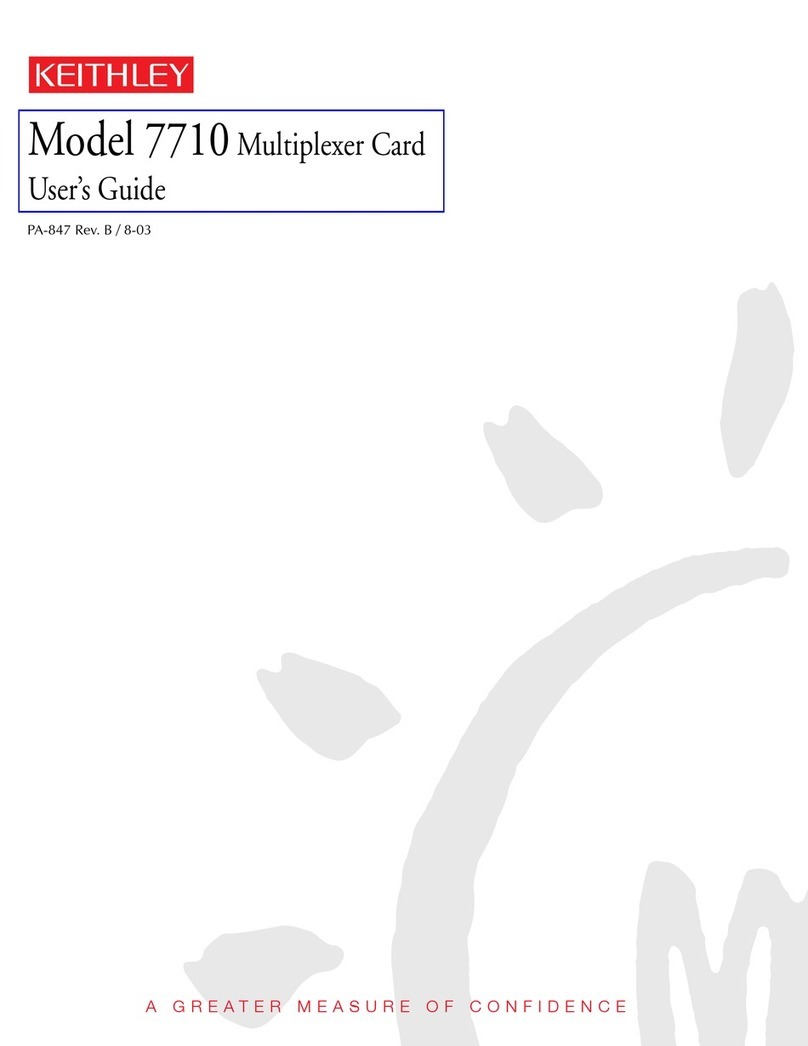
Keithley
Keithley 7710 User manual
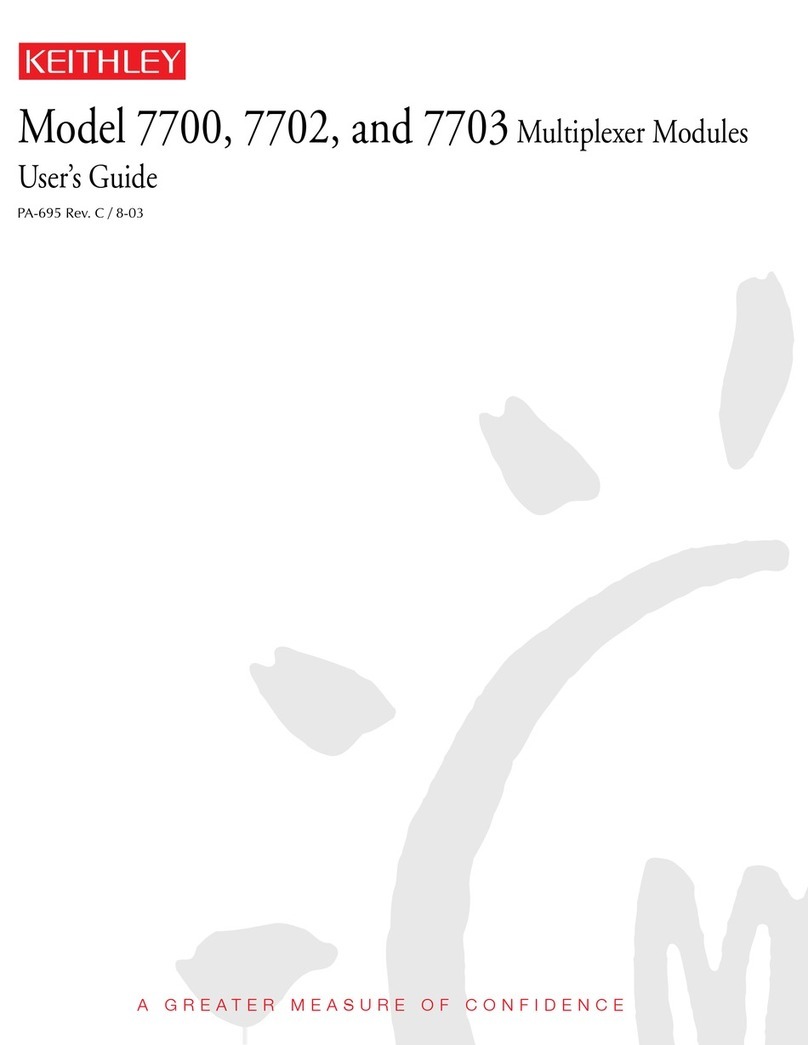
Keithley
Keithley 7702 User manual

Keithley
Keithley 7017 User manual
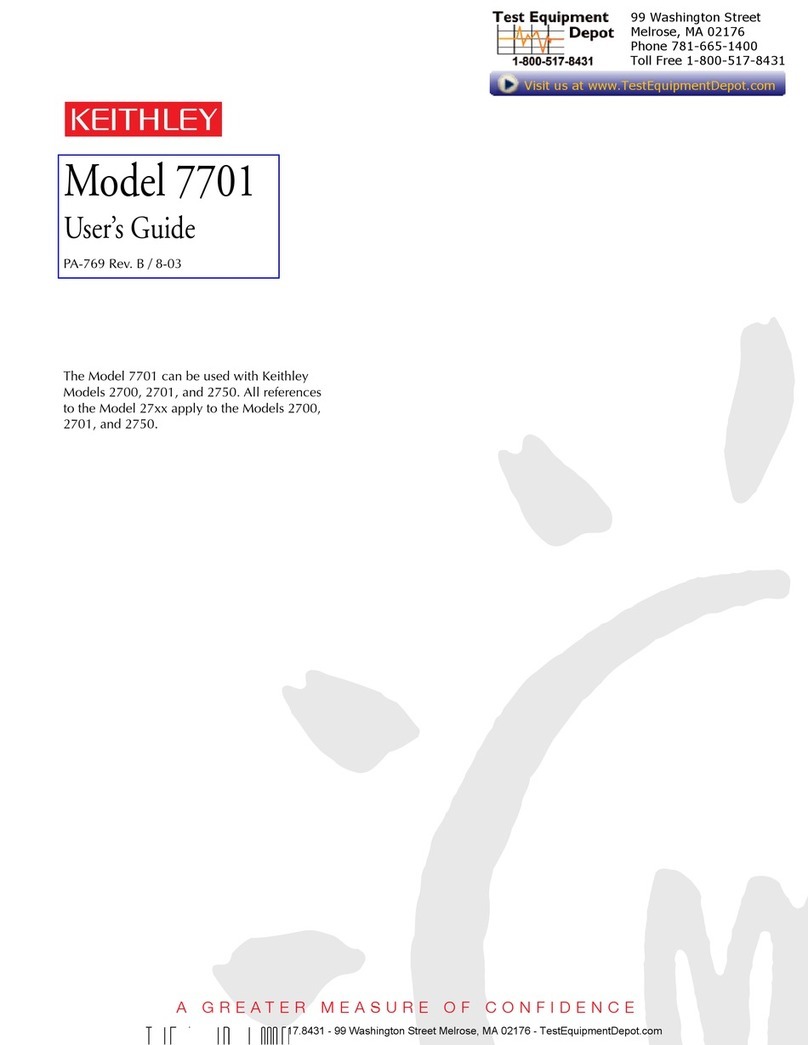
Keithley
Keithley 7701 User manual
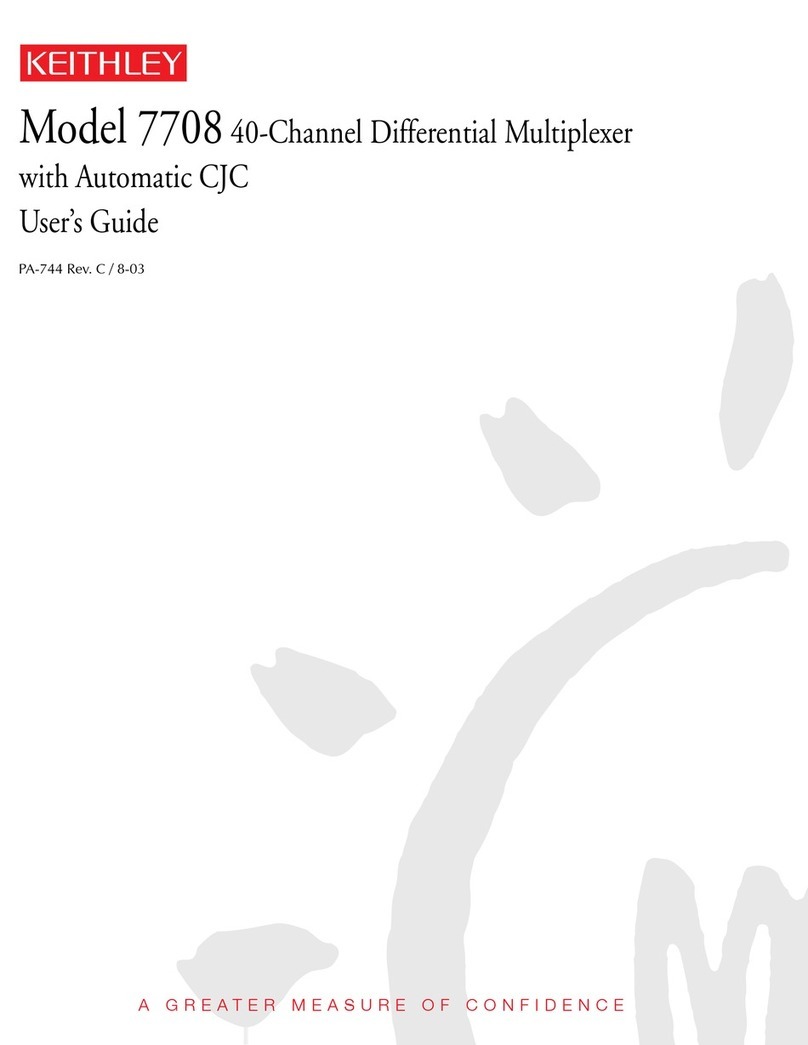
Keithley
Keithley 7708 User manual
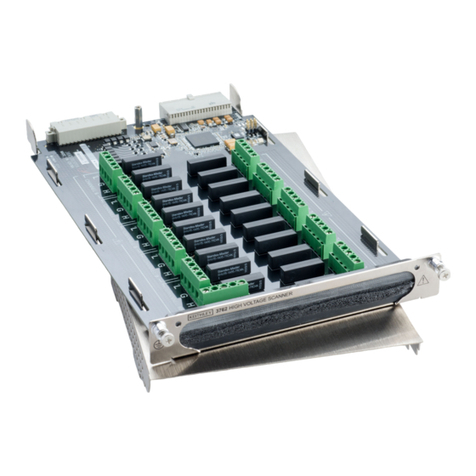
Keithley
Keithley 3706A User manual
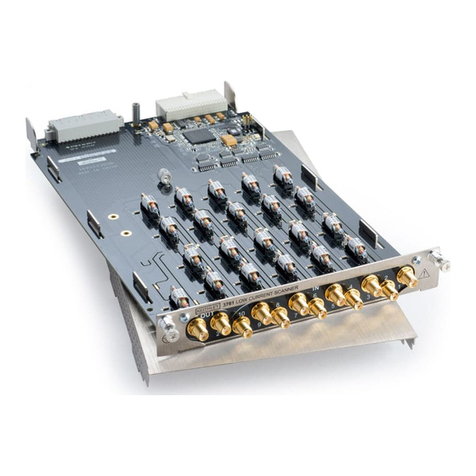
Keithley
Keithley 3761 User manual
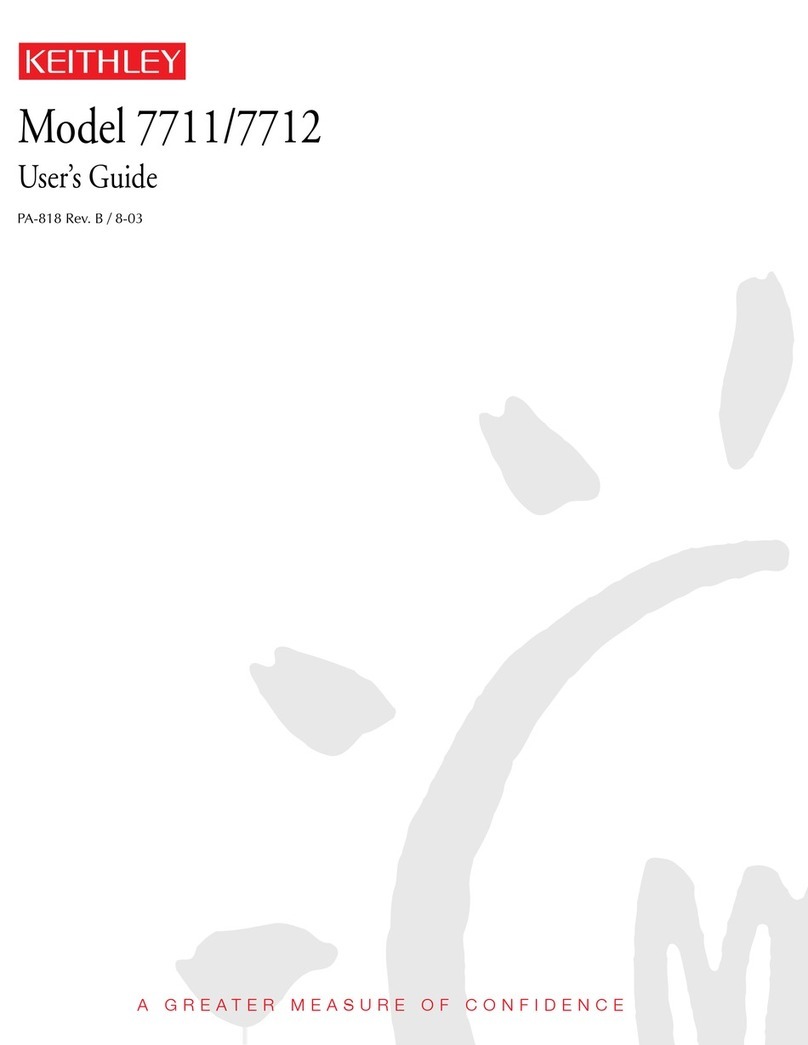
Keithley
Keithley 7711 User manual
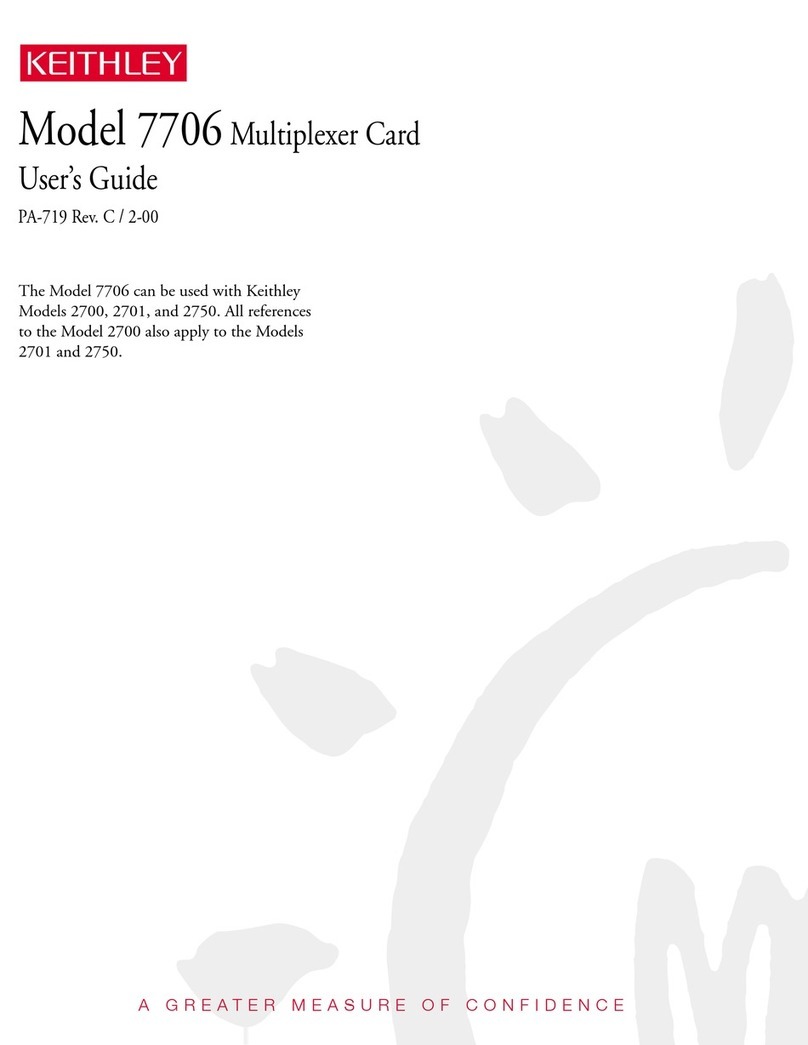
Keithley
Keithley 7706 User manual
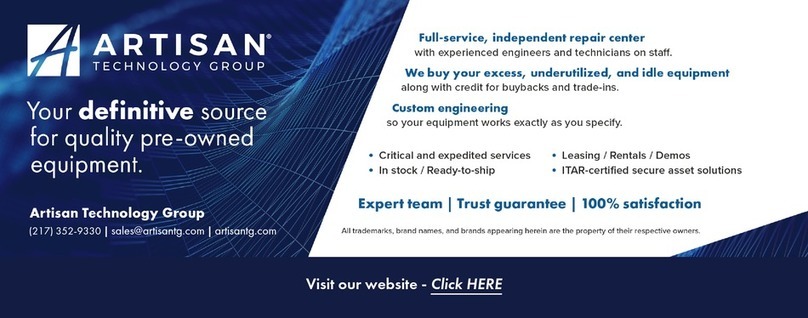
Keithley
Keithley EXP-16 User manual
Popular Multiplexer manuals by other brands
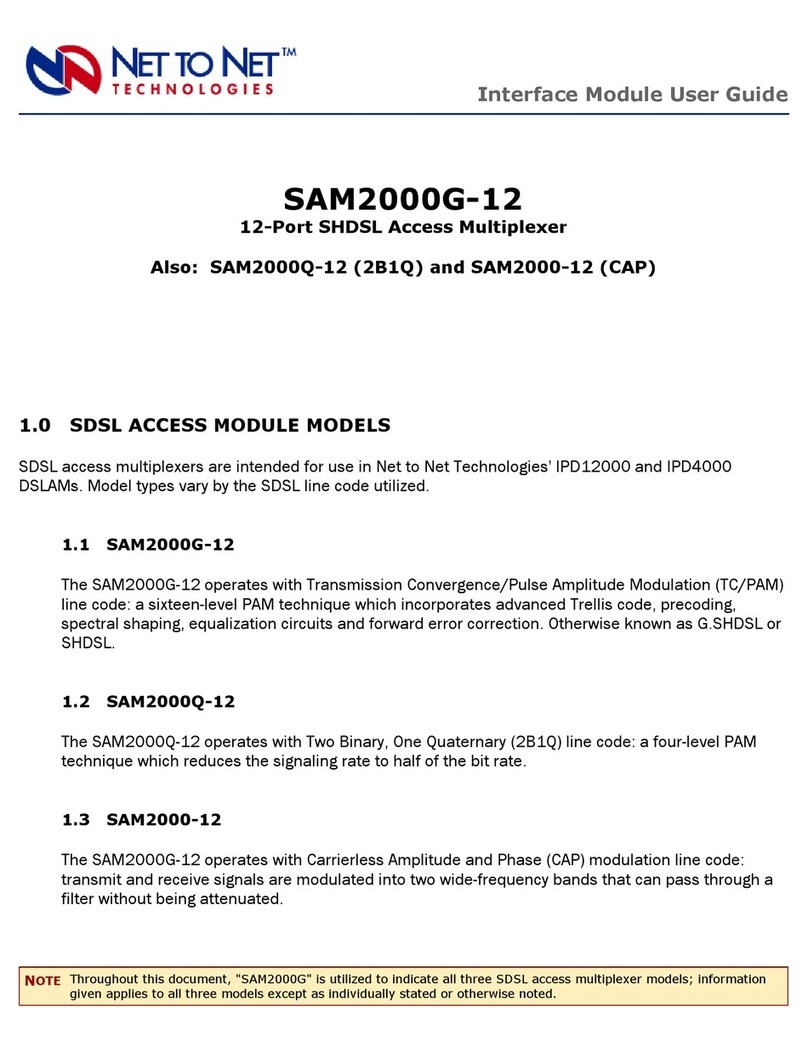
Net to Net Technologies
Net to Net Technologies 12-Port SHDSL Access Multiplexer SAM2000G-12 user guide
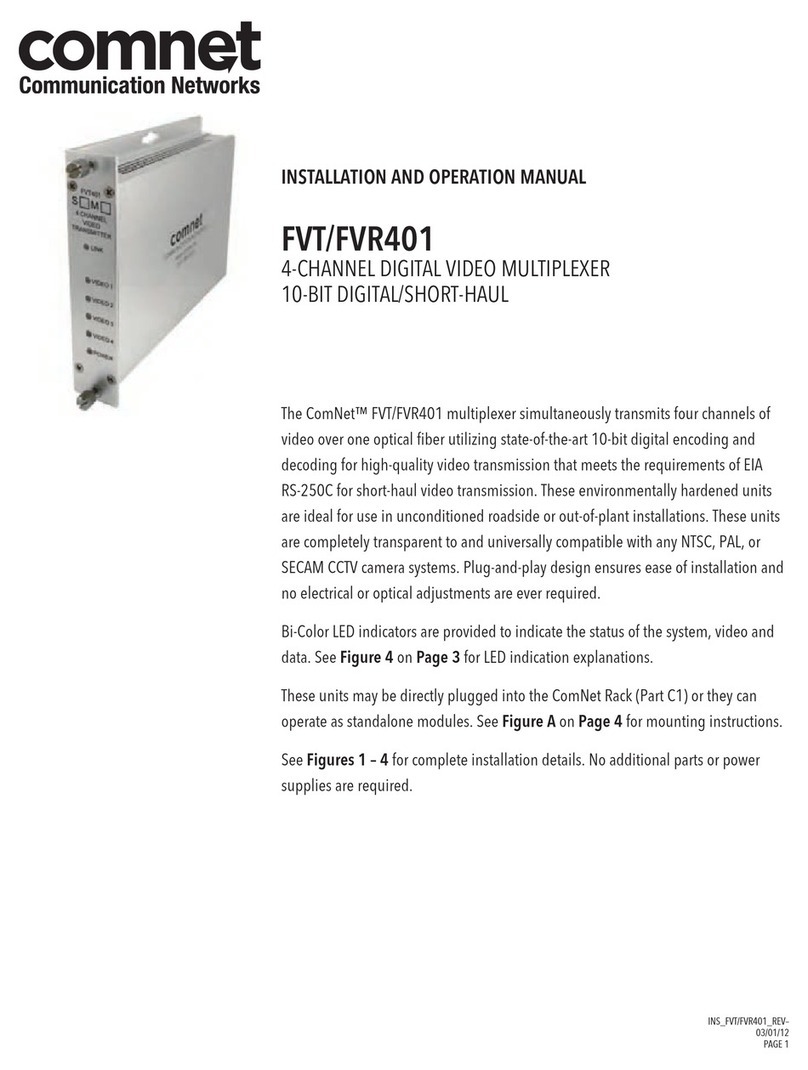
Comnet
Comnet FVR401 Installation and operation manual
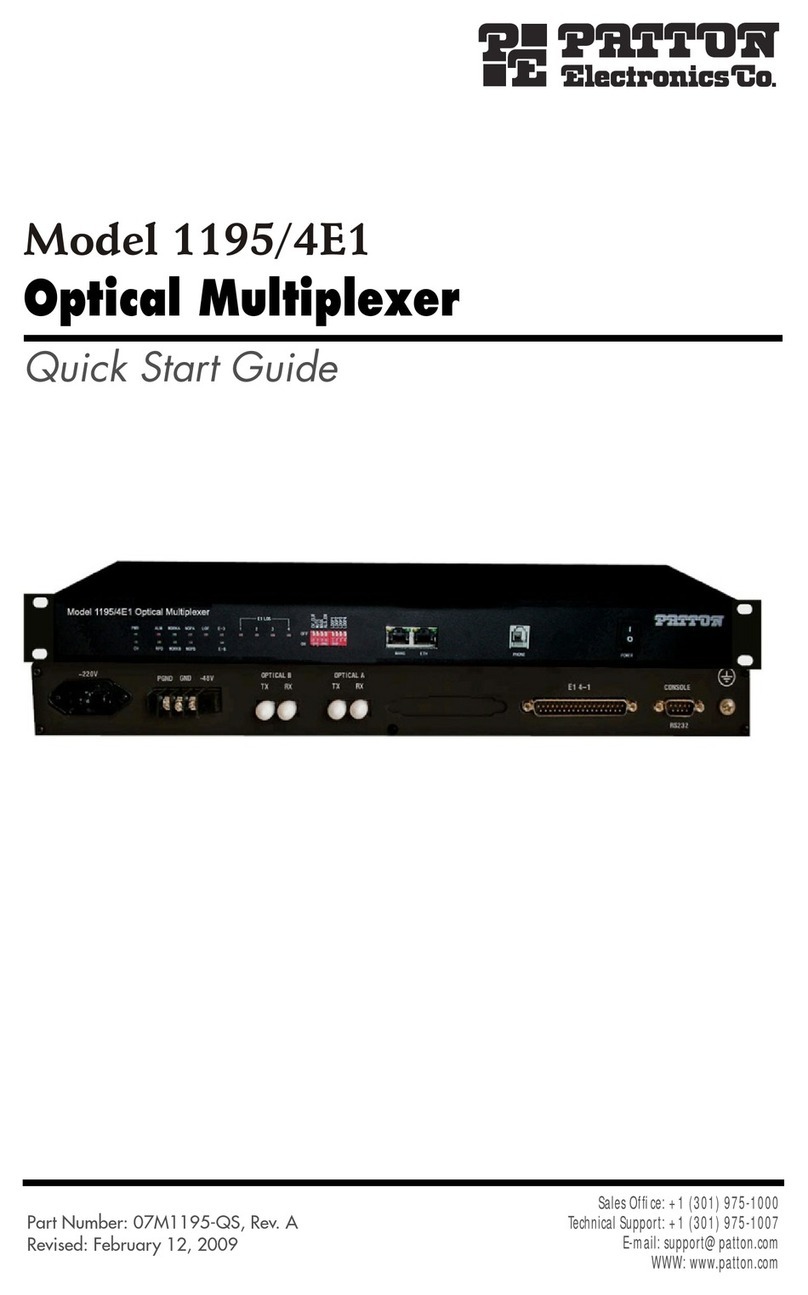
Patton
Patton 1195/4E1 quick start guide
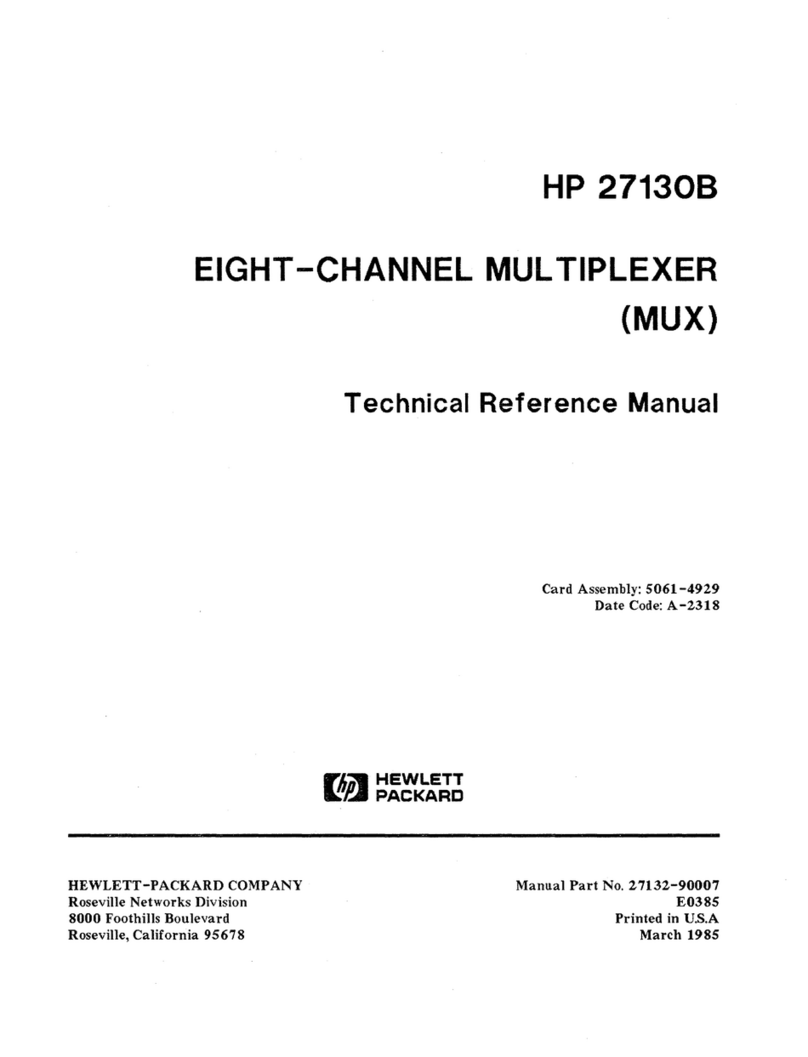
HP
HP 271308 Technical reference manual
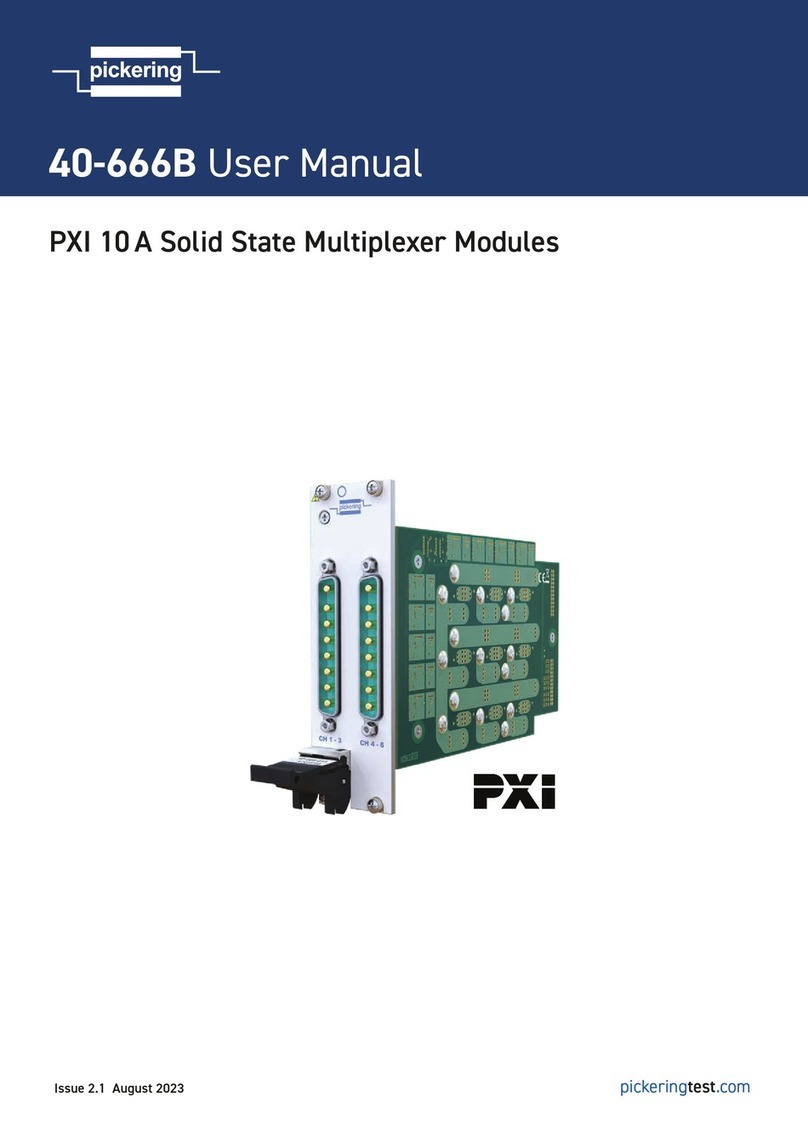
Pickering
Pickering 40-666B user manual
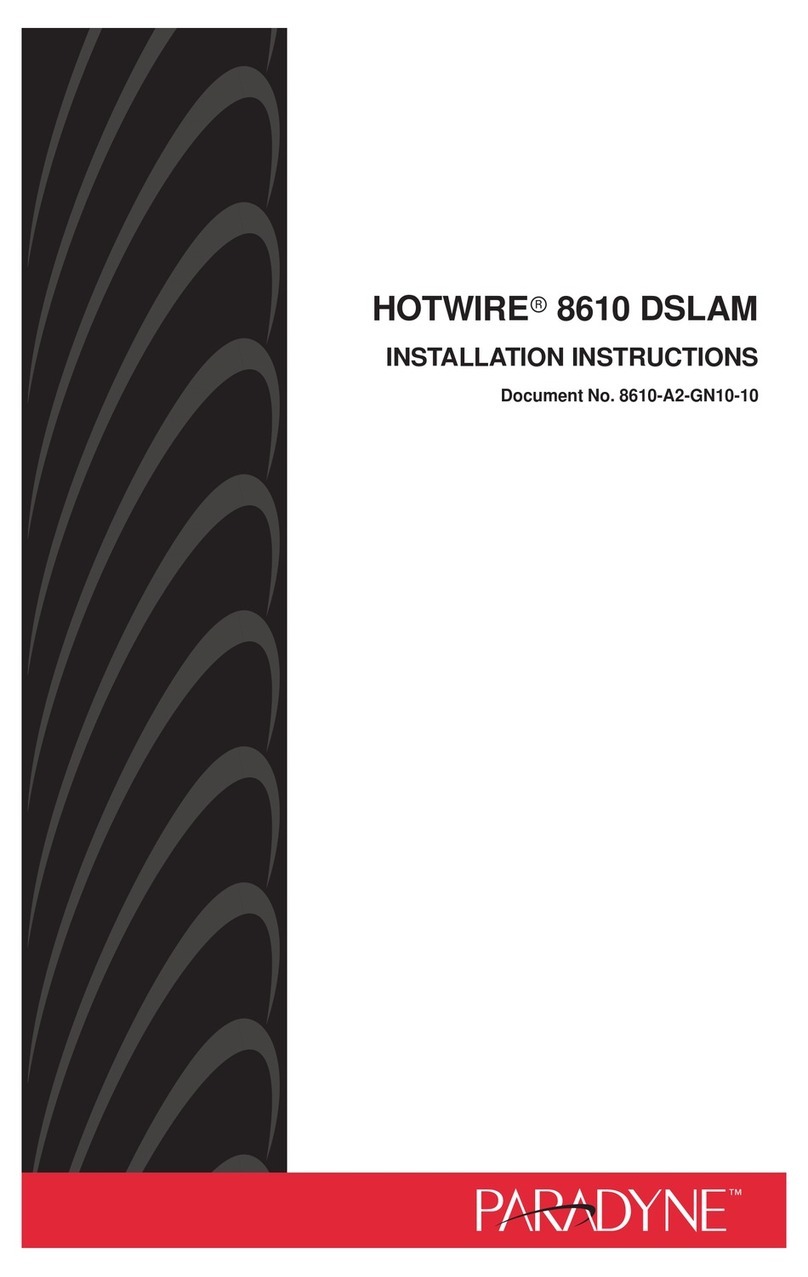
Paradyne
Paradyne HOTWIRE 8610 DSLAM installation instructions

